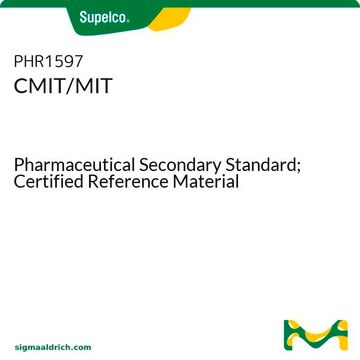Both ProClin 300 and Proclin 950 are only sold for use in In Vitro Diagnostic Use. Their usage is not allowed for Research Use Only (RUO).
48912-U
ProClin™ 300
ProClin™ preservative for use in IVD manufacturing, pkg of 50 mL, CMIT/MIT 3 %
Sinónimos:
3% solution of 5-chloro-2-methyl-4-isothiazolin-3-one and 2-Methyl-4-isothiazolin-3-one
About This Item
Productos recomendados
Formulario
liquid
caducidad
3 yr
contiene
Alkyl Carboxylate
composición
CMIT/MIT, 3%
envase
pkg of 50 mL
Parámetros
<45 °C operating temperature
color
colorless to light yellow
Matriz
Modified glycol
Intervalo de pH operativo
2.5-8.5
pH
4.1 (100 g/L)
bp
189 °C
mp
-40 °C
solubilidad
water: soluble
densidad
1.03 g/cm3
¿Está buscando productos similares? Visita Guía de comparación de productos
Descripción general
Aplicación
Acciones bioquímicas o fisiológicas
Información legal
Cláusula de descargo de responsabilidad
Palabra de señalización
Danger
Frases de peligro
Clasificaciones de peligro
Acute Tox. 4 Inhalation - Acute Tox. 4 Oral - Aquatic Acute 1 - Aquatic Chronic 1 - Eye Dam. 1 - Skin Corr. 1B - Skin Sens. 1
Código de clase de almacenamiento
8A - Combustible corrosive hazardous materials
Clase de riesgo para el agua (WGK)
WGK 3
Punto de inflamabilidad (°F)
244.4 °F - closed cup
Punto de inflamabilidad (°C)
118 °C - closed cup
Equipo de protección personal
Faceshields, Gloves, Goggles, type ABEK (EN14387) respirator filter
Elija entre una de las versiones más recientes:
¿Ya tiene este producto?
Encuentre la documentación para los productos que ha comprado recientemente en la Biblioteca de documentos.
Los clientes también vieron
Protocolos
The article describes the sample preparation and photometric determination of silver concentration in water samples using Spectroquant® photometers and test kits.
The article describes the sample preparation and photometric determination of silver concentration in water samples using Spectroquant® photometers and test kits.
The article describes the sample preparation and photometric determination of silver concentration in water samples using Spectroquant® photometers and test kits.
The article describes the sample preparation and photometric determination of silver concentration in water samples using Spectroquant® photometers and test kits.
Contenido relacionado
Products and support for mpox research, offering world-class reagents for immunoassay and molecular assay development.
Products and support for mpox research, offering world-class reagents for immunoassay and molecular assay development.
Products and support for mpox research, offering world-class reagents for immunoassay and molecular assay development.
Products and support for mpox research, offering world-class reagents for immunoassay and molecular assay development.
-
To use as a preservative for a buffer in an RUO kit, what are the reasons for using 48912-U over 46878-U?
1 answer-
Helpful?
-
-
What is the process of neutralizing ProClin, and can ProClin be safely disposed of as non-hazardous after neutralization?
1 answer-
ProClin 300 contains two active ingredients, CMIT and MIT. CMIT can degrade into non-hazardous by-products. MIT is less reactive and is degraded by various chemicals. The provided procedure degrades both the CMIT and MIT active ingredients, ensuring that once the solution is neutralized, CMIT and MIT are no longer present. The breakdown by-products are not hazardous.
Helpful?
-
-
Does anything in 48912-U interfere with Horseradish Peroxidase?
1 answer-
ProClin 300 is fully compatible with both horseradish peroxidase and alkaline phosphatase enzymes.
Helpful?
-
-
Is there more information about the modified alkyl carboxylate matrix used for ProClin 300?
1 answer-
The product is non-hazardous, the exact chemical composition of the modified alkyl carboxylate used in ProClin 300 is a proprietary information and hence not disclosed.
Helpful?
-
-
Is the recommended level for ProClin usage (0.025 to 0.05%) based on the active ingredient or the product as it is supplied in the bottle?
1 answer-
The percent of active ingredients found packaged in the bottle is 3% as it is supplied in the bottle. The recommended usage range for ProClin 300 is 0.025% to 0.050%, based on the product. Thus, an active range for use is represented between 7.5 to 15 ppm.
Helpful?
-
-
Proclin P30 preservative - what is the recommended shelf life from DOM?
1 answer-
The expiration date will be located on the lot-specific Certificate of Analysis.
Please access a Certificate in the DOCUMENTATION section of the product detail page:
https://www.sigmaaldrich.com/product/sial/48912-u#product-documentationHelpful?
-
-
Can I use proclin 300 for Blood and Plasma preservation? And can i use proclin 300 with K3 EDTA?
1 answer-
This product is used as a preservative in numerous products and preparations. Although it has been utilized in antibody preparations of ascites fluid, it is typically not used as a biocidal agent in whole blood, serum, or plasma. Suitability would have to be determined by the researcher. See the link below to review additional ProClin information:
https://www.sigmaaldrich.com/products/clinical-diagnostics/proclin-preservativesHelpful?
-
-
What is the working solution of ProClin? How to dilute ProClin?
1 answer-
While optimization may be required, the typical working range for ProClin 300 is 0.03 - 0.05%. See the link below for additional information on ProCliin product usage. Scroll down for the table referencing usage concentrations:
https://www.sigmaaldrich.com/products/clinical-diagnostics/proclin-preservatives.Helpful?
-
-
What is the Department of Transportation shipping information for this product?
1 answer-
Transportation information can be found in Section 14 of the product's (M)SDS.To access the shipping information for this material, use the link on the product detail page for the product.
Helpful?
-
-
What is the density of ProClin 300?
1 answer-
The density of ProClin 300 is reported as 8.59 pounds per gallon. The specific gravity at 22°C is reported as 1.03 g/mL.
Helpful?
-
Active Filters
Nuestro equipo de científicos tiene experiencia en todas las áreas de investigación: Ciencias de la vida, Ciencia de los materiales, Síntesis química, Cromatografía, Analítica y muchas otras.
Póngase en contacto con el Servicio técnico









